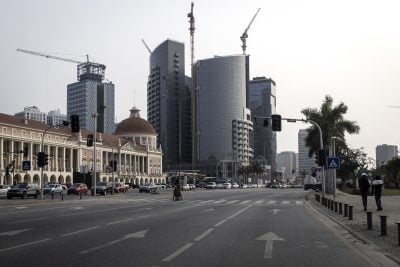Although Africa’s enormous agricultural potential has hardly been scratched, there has been a concentrated effort, by government, NGOs and the private sector to push for the long overdue green revolution that could completely transform Africa’s economic fortunes.
While Africa has huge agricultural potential, it still lags behind all other regions in food security. An estimated one third of the continent’s population is malnourished and famines are a recurring nightmare in several countries.
But could Africa’s fortunes in the agricultural sector be changing? Yes, according to Steven Schonberger, Regional Economist in the Western & Central Africa division at the UN’s Independent Fund for Agricultural Development (IFAD).
“There is a revolution – less dramatic and perhaps less visible – of farmers responding to improved opportunities resulting from higher global food prices and increased local demand from growing African cities. Agricultural growth rates in Africa are exceeding the rest of the world,” Schonberger says.
Following successful implementation of Green Revolutions in Latin America and Asia, there was a dramatic jump in productivity levels. As a result, the number of undernourished people in Asia tumbled from 41% in 1960 to 16% in 2000. And, due to the consequent drastic improvements in productivity and crop yields, disastrous famines predicted in India and China never took place.
Now governments hope it is Africa’s turn. At a governmental level, there has been a remarkable shift in terms of prioritisation of agricultural development. In 2003, Africa reached a turning point in the form of the Maputo Declaration on Agriculture and Food Security. In the Maputo Declaration, signed by heads of states and government in Africa, countries committed to allocating at least 10% of their national budgets to agriculture within a five-year time frame.
Agriculture experts have similarly big ambitions for Africa’s agricultural future. Jane Karuku, President of the Alliance for Green Revolution in Africa (AGRA), has a vision and is confident it can be achieved. (See interview with Mrs Karuku.)
She wants to see a doubling of incomes for 20m smallholder farming families in Africa and a reduction of food insecurity by 50% in no less than 20 African nations. Karuku also wants to see at least 15 countries on the path that will enable them to “attain and sustain” a Green Revolution that bolsters smallholders and is environmentally friendly and sustainable. Staying true to the essence of revolution, Karuku also appears confident that dramatic change can take place in a relatively short time frame. Within a decade, she thinks that Africa can “deliver a more food secure, prosperous continent achieved through rapid, sustainable agricultural growth based on smallholder farmers who produce staple food crops”.
Encouragingly, in two crucial areas that Karuku mentions – help for smallholder farmers and environmentally sustainable farming – Africa is indeed making real progress.
Empowering smallholders
For a long time, smallholders were neglected by African governments and local and international NGOs in the formulation of new policies and strategies for boosting agriculture. However, according to a report by the African Smallholder Farmer Group (ASFG), since the beginning of the 21st century, attention has moved back towards agricultural development and, smallholder farming units are, thankfully, capturing their fair share of the limelight. That shift in focus is visible on multiple levels. High-level NGOs such as USAID have clearly registered the importance of zoning in on smallholder farmers – their $3.5bn ‘Feed the Future’ programme, which is geared at tackling global food insecurity, concentrates explicitly on smallholders. Development literature with smallholders as the main focus, such as Roger Thurow’s The Last Hunger Season, published in May this year, is becoming more prolific.
In order to make smallholders more effective, ASFG advocates a number of measures, including focus on areas such as market access and gender.
“Small-scale farming systems must be prioritised, along with smallholder farmers’ ability to access local and international markets. In addition, there is a growing awareness that women smallholder farmers face particular constraints and need special support,” says the report.
A widespread concern for those with an interest in smallholder farming is indeed the restricted access that local farmers have to markets and their limited resources to meet the demands of those markets. That has, in turn, given rise to an impressive host of innovative suggested solutions. One that is particularly interesting focuses on the intermediary as well as the farmer. The International Institution for Environment and Development (IIED) has just published a report, written by Abbi Buxton and Bill Vorley, focusing on this area.
They stress the fundamental importance of the intermediary as the cog in the agricultural wheel that ensures that small-scale farmers can be brought together with large retailers and benefit from that business relationship. For Buxton and Vorley, the intermediary, given the rights tools and investment, then becomes capable of establishing a clear route to market for smallholders and is able to fill otherwise glaring gaps in the supply chain – such as relevant information flows and delivery.
The IIED has successfully undertaken a pilot project to prove their hypothesis, enabling an intermediary in the floriculture industry. Wilmar Agro Limited, based in Kenya, buys flowers from thousands of smallholders. IIED helped to form a business relationship with Sam’s Club, the US subsidiary of Walmart as well as UK retailers such as Asda. Thus the intermediary, in this case Wilmar acts as the bridge between the smallholders and some of the world’s largest retailers. It is a powerful demonstration of what can be achieved in this area. Others have focused more directly on smallholder farming units themselves and how to improve their performance. The University of Greenwich’s Natural Resources Institute, for example, sees an improvement of risk management within shareholder farming communities as essential, and is undertaking a new project to improve progress in this area.
It is due to launch in the autumn in Burkina Faso, Tanzania and Zambia and will concentrate on a host of areas to improve risk management – from crop and livestock insurance and loan programs to the provision of warehouse receipts to protect the value of stored product. The project will also investigate ways to improve market information systems and how farmers can positively affect government policies.
Commodity exchanges, such as the very successful one in Ethiopia, gives farmers the flexibility to negotiate prices directly with buyers and use warehouse receipts as collateral for loans. Similar structures in India have vastly increased the income of farmers.
There has also been a dramatic change in the agricultural sector in terms of willingness to addressing questions of gender. Women constitute 70% of agricultural workers in Africa and make up 80% of individuals featured in the food processing value chain. According to the UN, greater gender equality in the domain of agriculture could improve productivity in the developing world by between 2.5 and 4%, which translates into 17% less people going hungry. Although, for decades, strategies for increasing agricultural production on the continent have been targeted at men, women are now increasingly in the spotlight. NGOs like the Swedish International Development Corporation Agency (SIDA) want to improve access to land and farming apparatus for female agriculturalists and run projects to tackle legal illiteracy amongst female farmers.
There are also signs that the sector has woken up to the importance of training more female leaders and pioneers in agricultural science and innovation, which, in Africa, remains a very much male-dominated arena. The African Women in Agricultural Research and Development Programme (AWARD) provides a two-year fellowship for African women, offering training in crucial areas of agriculture and agricultural science, such as water and irrigation, crop science and horticulture.
Progress is also being made in terms of environmental and sustainable agriculture. In a study undertaken in East Africa by the Research Programme on Climate Change, Agriculture, and Food Security of the Consortium of International Agricultural Research Centers, (CIGAR) found that half of the households studies partake in agroforestry (planting trees), which in turns improves water supply and soil quality.
Fifty per cent also practise intercropping – alternating various plants in a given plot – a quarter of households having introduced this practice within the last 10 years, while 34% of those surveyed had reduced the size of their livestock herds and 48% are now managing their resources in a superior way through approaches such as growing crops for animal feed.
According to the study, a third of agropastoral households in Ethiopia and one fifth of such collectives in Tanzania are also getting better at managing their pasture through measures such as planting superior forage varieties and ensuring grazing areas are separated from cropland.
This leads to a more balanced and far more efficient use of resources. Agroforestry not only helps in mitigating the effects of climate change, it tends to improve soil quality and water management.
CIGAR now wants to roll out innovative environmentally sensitive practices on a wider scale. It has called for the adoption of SMS messaging to ensure that farmers can get more immediate access to weather forecasts and other market intelligence.
It also advocates insurance for livestock farmers in case of drought. It aims to make climate-resilient crop varieties immediately available to farmers and wants to tap into the global carbon credits markets so that farmers can be directly rewarded for participating in sustainable agriculture.
Government policy successes
The focus on smallholder farms notwithstanding, government policy in several cases has led to steep increases in production. Malawi and Rwanda in particular have enjoyed impressive increases in agricultural productivity as a result of government policies.
Over the past few years, Malawi’s agricultural sector has been transformed. Malawi’s farming revolution goes back to its 2005 food crisis, when maize production tumbled to 1.2m tonnes with a third of the country’s population facing starvation. In response the government doubled its agricultural budget to over 16% and used the money to fund a $74m subsidy programme. Coupons to buy agricultural inputs like seeds and fertilisers were given to millions of the country’s farmers. The result: maize yields increased from 1.23m tonnes in 2004/5 to 3.44m tonnes in 2006/7. Cassava yields also jumped from just over 14 tonnes per hectare to more than 19 tonnes per hectare between 2005/9. Groundnut yields almost doubled from 2004 to 2009.
Rwanda has also enjoyed recent agricultural success. The government has invested heavily in a programme aimed at productivity and production. There has been focus, for example, on introducing new seeds and pesticides, boosting access to credit and erosion control. As a result, agricultural production has improved by 14% per year.
In West Africa, Ghana has also made noticeable improvements in its agricultural sector – the GDP growth rate of the agricultural sector increased from 2.1% in 2000 to 6.2% in 2009. Total production of food crops has equally risen from approximately 17m tonnes to around 26,000m tonnes. Crops which are being produced on a larger scale include maize, millet, rice and cassava.
Overall, therefore, the transformation in Africa is fairly well distributed in geographic terms. “East Africa and some countries in West Africa – particularly along the coastal areas – are tending to show the most sustained growth in agricultural production, supported by a combination of improved government policies and consequent growth in private investment by farmers in production and by domestic and international companies in processing for domestic and international markets,” says IFAD’s Schonberger. “However, while these countries enjoy quite good agro-ecological conditions, the measures they have taken are generally transferable to anywhere on the continent and would have similar, positive results in terms of private-sector-led growth throughout the agricultural supply chain.”
Challenges
There are, inevitably multiple challenges to ensuring that progress in African agriculture takes shape in the areas outlined in this report. As Jane Karuku states in her interview with African Business, more investment from African governments, donors and the private sector is key. It should not be taken for granted that agriculture is getting fair slices of the aid and investment pies in Africa – although the amount of development aid received by Africa has jumped by 250% since the 1980s, the proportion of that money going into agriculture has halved.
“Despite recent improvements, official development aid for African agriculture, targeted at marginalised farmers, should be increased significantly to reverse the impact of years of underinvestment,” according to the ASFG report.
Moreover, some argue that there needs to be more careful thought on how money is spent. For example, Jane Karuku calls for a more balanced utilisation of funds across different sectors in agriculture. And others, such as ASFG want to see more investment in areas like technology.
In terms of smallholders, various difficulties still need to be resolved. Critics argue that there has been too much emphasis on short-term inputs and getting immediate results in terms of productivity. The cost has been a failure to address fundamental issues such as farming skills, access to equipment and land and lack of rigorous debate about what government agricultural policy should look like.
There have, equally been calls for more emphasis on using the community as a vehicle through which to ensure that new approaches to farming take root in rural areas.
“Farmer and community organisations can act as a vehicle in disseminating new technologies, knowledge and resources, and they can also be used as a springboard for other community development activities,” according to the AFSG report.
Dealing with gender imbalances in the sector will prove no less difficult. Underlying gender inequalities in agriculture in Africa are enduring cultural norms. Women often need permission to change their crops or participate in development programmes. They also tend to have less numeracy and basic reading and writing skills, which puts them at a clear disadvantage. Empowering women as agriculturalists will, therefore, take time and much effort to overcome.
Finally, in the arena of climate change and the need for sustainable agriculture, such forms of farming still struggle to get the support and attention they need from African governments. There is much focus on agrochemical subsidies but less on environmentally friendly, organic agriculture.
There is also a pervading ignorance about organic farming in Africa that urgently requires addressing – it is often wrongly generalised as simply farming without chemicals, a potentially dangerous interpretation that does little to advance the cause.
“Africa’s future is not as a continent of happy peasants,” Professor Paul Collier of the University of Oxford recently warned. “It will adopt the American model of successful development based on an abundance of land. Happy American peasants have become the preserve of Hollywood nostalgia.”
Collier’s warning not to overromanticise rural life or overemphasise the role it will play in deciding Africa’s economic fortunes, is a sensible one. But African agriculture is still hugely important. And a Green Revolution is well on the way.
Want to continue reading? Subscribe today.
You've read all your free articles for this month! Subscribe now to enjoy full access to our content.
Digital Monthly
£8.00 / month
Receive full unlimited access to our articles, opinions, podcasts and more.
Digital Yearly
£70.00 / year
Our best value offer - save £26 and gain access to all of our digital content for an entire year!
 Sign in with Google
Sign in with Google 


